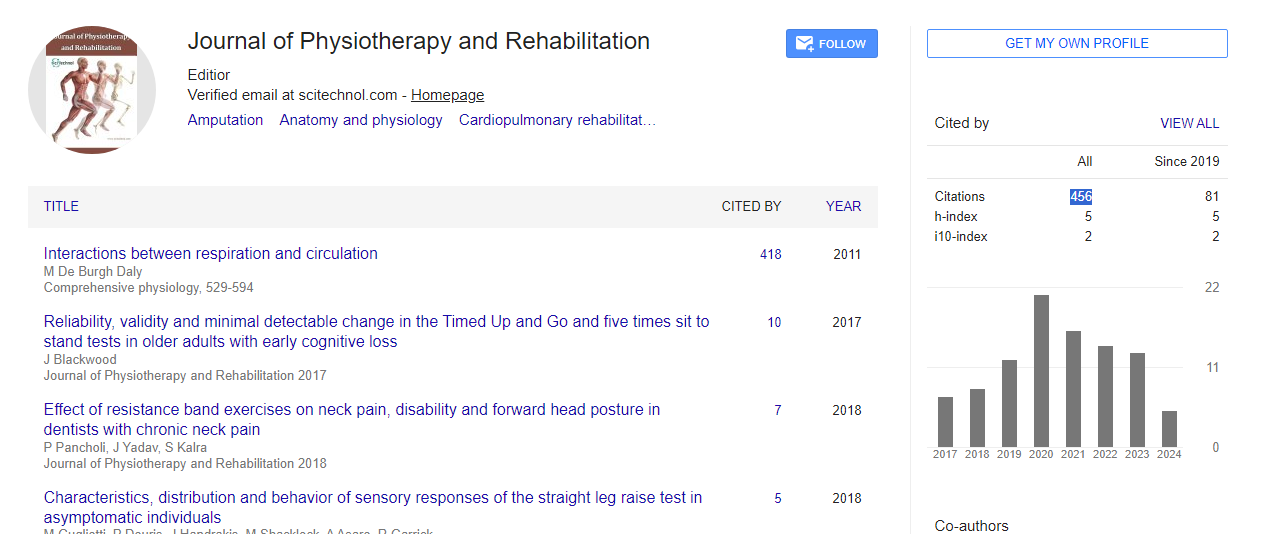Perspective, J Physiother Rehabi Vol: 8 Issue: 6
Role of Rheumatological Rehabilitation in Managing Chronic Inflammatory Diseases: A Comprehensive Approach to Pain Management and Mobility Enhancement
Philip Bruton*
1Department of Physiotherapy, University of Otago, Christchurch, New Zealand
*Corresponding Author: Philip Bruton,
Department of Physiotherapy, University of
Otago, Christchurch, New Zealand
E-mail: philip@brat.nz
Received date: 23 November, 2024, Manuscript No. JPTR-24-155489;
Editor assigned date: 25 November, 2024, PreQC No. JPTR-24-155489 (PQ);
Reviewed date: 09 December, 2024, QC No. JPTR-24-155489;
Revised date: 17 December, 2024, Manuscript No. JPTR-24-155489 (R);
Published date: 24 December, 2024, DOI: 10.4172/JPTR.1000200.
Citation: Bruton P (2024) Role of Rheumatological Rehabilitation in Managing Chronic Inflammatory Diseases: A Comprehensive Approach to Pain Management and Mobility Enhancement. J Physiother Rehabi 8:6.
Description
Rheumatological rehabilitation plays an essential role in the management of chronic inflammatory diseases, providing patients with effective strategies for pain management, mobility enhancement and overall quality of life improvement. Chronic inflammatory diseases, such as rheumatoid arthritis and psoriatic arthritis, can cause debilitating pain, joint damage and functional limitations. While medication is often a foundation of treatment, rehabilitation therapies complement pharmacological interventions by addressing the physical, psychological and functional aspects of these conditions. This complete approach is essential for managing symptoms and preventing long-term disability. One of the primary goals of rheumatological rehabilitation is to manage pain, a common and distressing symptom for many individuals with chronic inflammatory diseases. Chronic pain can result from joint inflammation, tissue damage and muscle imbalances. Traditional pain management often involves the use of anti-inflammatory drugs, pain relievers and disease modifying antirheumatic drugs, but rehabilitation techniques offer additional support in managing pain effectively. Physical therapy, for example, focuses on reducing joint stiffness, improving muscle strength and enhancing range of motion, which can alleviate pain and prevent further joint damage.
Furthermore, therapeutic exercises personalized to the specific needs of individuals with chronic inflammatory diseases play a significant role in both pain management and mobility enhancement. Exercise is essential for maintaining and improving joint function, muscle strength and flexibility, which can all be compromised by inflammatory diseases. Low-impact aerobic exercises, such as swimming and cycling, are often recommended improving cardiovascular health without putting excessive stress on the joints. Strengthening exercises target the muscles surrounding the affected joints, providing additional support and reducing the risk of further damage. Stretching exercises are also essential for improving flexibility and preventing joint contractures, which can limit mobility. By engaging in these exercises regularly, patients can reduce pain, improve joint stability and increase their ability to perform daily activities. Occupational therapists work with patients to enhance their ability to perform everyday tasks, such as dressing, cooking and cleaning, despite the physical limitations imposed by their condition. By using assistive devices, teaching energy conservation techniques and modifying home environments, occupational therapists help patients maintain independence and improve their quality of life. Rheumatological rehabilitation also addresses the psychological aspects of living with chronic inflammatory diseases. Chronic pain and disability can lead to feelings of irritation, anxiety and depression, which can, in turn, worsen physical symptoms.
A complete approach to rehabilitation includes psychological support, which can take the form of counseling, Cognitive Behavioral Therapy (CBT), or mindfulness techniques to help patients cope with the emotional challenges of chronic illness. In some cases, group therapy or support groups provide an opportunity for patients to share experiences, learn from others, and feel less isolated in their struggles. Rheumatological rehabilitation aims to prevent long-term disability by focusing on early intervention and proactive care. Inflammatory diseases, if left untreated or poorly managed, can lead to joint deformities, reduced mobility and chronic pain that significantly impact a person’s ability to perform daily activities. By starting rehabilitation early in the course of the disease, healthcare professionals can help minimize these risks, slowing down or even halting disease progression. This proactive approach involves regular monitoring, adjustments to treatment plans and timely interventions to address any emerging issues. The importance of a multidisciplinary approach in rheumatological rehabilitation cannot be excessive.
Conclusion
Rheumatological rehabilitation plays an essential role in the management of chronic inflammatory diseases. Through a combination of pain management, therapeutic exercises, occupational therapy, psychological support and self-management education, rehabilitation helps individuals with these conditions regain mobility, enhance their quality of life and prevent long-term disability. By providing patients with the tools they need to manage their symptoms effectively, rheumatological rehabilitation offers a pathway to better health and comfort, empowering patients to lead active, independent lives despite the challenges posed by chronic inflammatory diseases.
 Spanish
Spanish  Chinese
Chinese  Russian
Russian  German
German  French
French  Japanese
Japanese  Portuguese
Portuguese  Hindi
Hindi 